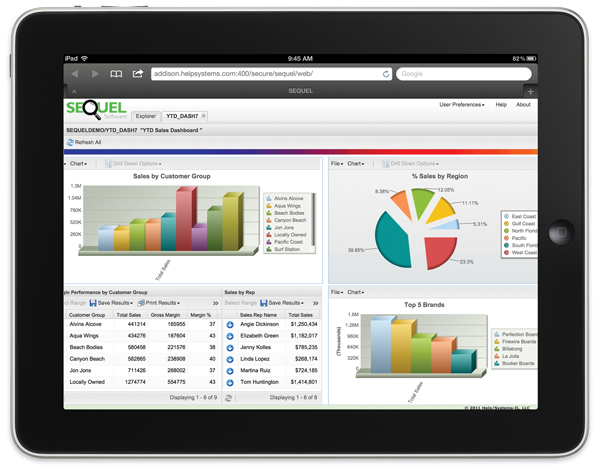Update your reports with SQL and SEQUEL.
You've heard that utilizing SQL is the most efficient way to access your data, but maybe you're hesitant to change your data access solution because of the potential learning curve. Your users are asking for updated reports, dashboards, shortcuts, web access, and more, but some legacy software's queries look "old fashioned." How can you deploy improvements? There are three easy steps.
1) Determine What Data Your Analysts Really Need
Providing what's required may sound simple, but depending on the type of data requested, it can be challenging to find out what's really needed by your analysts. In reality, business analysts often ask their IT department or report designers for more reports when what they really need is better reports.
When IT meets with the analysts to determine what data they need and what they do with it, IT staff will be able to eliminate manual steps for the analysts by providing them with the information they actually need right away. This is the first step to modernizing your reports. It may be as simple as adding prompts so the analysts can run their specific reports on demand with different date ranges, different product lines, different divisions, etc., or it may be merging data from different databases into one new consolidated report.
SEQUEL provides the flexibility to meet most, if not all, of the reporting needs for business data analysts. You can create dashboards so the analysts can get all of their information in a single place, and their manual data manipulation is reduced or eliminated thanks to being able to preset reports and queries. You can even use a job scheduler, such as Robot/SCHEDULER or the built-in scheduler on IBM i, to automate queries and build reports based on a specific schedule. By using SEQUEL, the data analysts receive is closer to their actual needs.
2) Upgrade the Look and Flow of Your Reports
The next step is the appearance of the information. Many business analysts like Excel documents because they can format the look and feel of the data themselves, while many executives and managers need to know specific, current, accurate information right away.
Instead of dropping everything to fulfill a report request, wouldn't it be timesaving to set up a desktop icon that launches a dashboard with current data any time users need it? Put the power into your users' hands so you are free to focus on other pressing, and possibly neglected projects.
With SEQUEL, you can design a dashboard with data, graphs, gauges, and more. You can creatively provide the managers what they need to see through SEQUEL's easy-to-learn, easy-to-use graphical tool.

Figure 1: Design a dashboard with data, graphs, gauges, and more.
3) Improve Report Processing with SQL and SQE
IT used to encourage analysts to use a manual PC file for insight in order to avoid slow report generation from older OS versions and green-screen reporting tools. IBM i's newer SQL Query Engine (SQE) has dramatically improved the speed and performance of reports. Unfortunately, not all tools allow you to use the SQE. Query/400, for example, still uses only the Classic Query Engine (CQE).
With SEQUEL, you can design your data access requests to use the SQE and improve processing time while increasing productivity. A simple setting in properties can reduce report-generation time dramatically. Some SEQUEL users have seen their query times go from hours to less than a minute (results vary based on the SQL design, system activity, and data size).
SEQUEL makes the transition into using SQL and the SQE relatively painless. With its easy-to-learn GUI interface and loaded functionality, SEQUEL allows you to create modern reports with the information analysts need, whether they want it in an Excel-like grid or a PC-formatted report suitable for clients.
Take the first step toward finding true data empowerment for your organization. Learn more about how SEQUEL can quickly query, process, and display your data today. Request a demo and free trial. You'll be surprised by how quickly your report requests will drop, and you'll open up your schedule to focus on bigger projects.












 Business users want new applications now. Market and regulatory pressures require faster application updates and delivery into production. Your IBM i developers may be approaching retirement, and you see no sure way to fill their positions with experienced developers. In addition, you may be caught between maintaining your existing applications and the uncertainty of moving to something new.
Business users want new applications now. Market and regulatory pressures require faster application updates and delivery into production. Your IBM i developers may be approaching retirement, and you see no sure way to fill their positions with experienced developers. In addition, you may be caught between maintaining your existing applications and the uncertainty of moving to something new. IT managers hoping to find new IBM i talent are discovering that the pool of experienced RPG programmers and operators or administrators with intimate knowledge of the operating system and the applications that run on it is small. This begs the question: How will you manage the platform that supports such a big part of your business? This guide offers strategies and software suggestions to help you plan IT staffing and resources and smooth the transition after your AS/400 talent retires. Read on to learn:
IT managers hoping to find new IBM i talent are discovering that the pool of experienced RPG programmers and operators or administrators with intimate knowledge of the operating system and the applications that run on it is small. This begs the question: How will you manage the platform that supports such a big part of your business? This guide offers strategies and software suggestions to help you plan IT staffing and resources and smooth the transition after your AS/400 talent retires. Read on to learn:
LATEST COMMENTS
MC Press Online